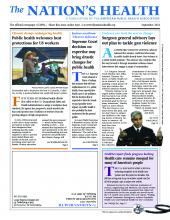
Farmworkers take a break from the heat in Camarillo, California, in July. A proposed federal rule would help protect workers.
Photo by Etienne Laurent, courtesy AFP/Getty Images
Fifty years after federal health officials first called on the U.S. Occupational Safety and Health Administration to adopt a workplace heat standard, the agency has proposed a much-needed rule that could protect tens of millions of workers from the growing dangers of high temperatures.
In July, OSHA proposed a new rule to keep outdoor and indoor workers safe from dangerous heat, outlining specific steps employers would be required to take to prevent heat-related illness and deaths on the job, such as providing water and rest breaks. Worker advocates praised the new proposal — which OSHA began drafting in 2021 — and stressed the importance of such protections in the face of record-breaking hot temperatures and predictions that climate change will make the problem worse.
“The OSHA proposal is long-awaited but urgently needed,” APHA member Rebecca Reindel, MPH, MS, director of occupational safety and health at AFL-CIO, told The Nation’s Health. “With more extreme climate and weather events, this issue has only been exacerbated.”
Nearly 1,000 workers died from job-related heat exposure between 1992 and 2022, according to federal labor statistics, with 43 such deaths in 2022 alone. Workers also experienced nearly 34,000 job-related heat injuries and illnesses from 2011 to 2020 that involved days away from work. However, advocates agree — and OSHA acknowledges — that such incidents are most likely significantly undercounted.
OSHA estimates that its proposed heat rule would protect about 36 million outdoor and indoor workers if finalized, from construction and agricultural workers to warehouse and manufacturing workers. Among its measures, the rule would require employers to create injury and illness prevention plans related to heat risks, allow new workers time to acclimatize to heat, provide heat safety training to workers and supervisors, and implement interventions when working conditions reach certain temperatures.
For example, the proposal has two temperature thresholds that trigger preventive action from employers. One is at 80 degrees, when employers would have to provide drinking water and rest breaks. The second is at 90 degrees, at which point employers must also provide a minimum 15-minute, paid rest break at least every two hours.

A firefighter pours water over his head during 105-degree weather in Beaumount, California, in July 2023.
Photo by Gina Ferazzi, courtesy The Los Angeles Times/Getty Images
“Workers all over the country are passing out, suffering heat stroke and dying from heat exposure from just doing their jobs, and something must be done to protect them,” said Doug Parker, JD, U.S. assistant secretary for occupational safety and health, in a news release. “(This) proposal is an important next step in the process to receive public input to craft a ‘win-win’ final rule that protects workers while being practical and workable for employers.”
The new OSHA requirements would come with new costs to employers, and worker advocates expect industry to strongly oppose the national heat rule during its public comment period. But heat-related work injuries also come with high costs.
A 2021 study from the Washington Center for Equitable Growth that examined California state workers’ compensation data found that hotter temperatures significantly increased workplace injuries, causing about 20,000 injuries per year. The impacts of such injuries, such as needing medical care and wage loss, could be as high as $875 million each year in California alone.
Jordan Barab, MA, former deputy assistant secretary at OSHA, said even though OSHA’s proposed heat standard still has many months to go in the rule-making process, and a final rule would not be expected for a few years, it can still start having an impact.
“One of the most effective things OSHA can do beyond a final rule is a proposed one because employers start getting ready for it,” Barab told The Nation’s Health.
In addition to the rulemaking process, the heat rule will likely face legal and political challenges as well. Barab predicts that if it is finalized, some employers will sue, which could present new legal difficulties stemming from the U.S. Supreme Court’s recent decision to strike down what is known as the “Chevron deference.” The doctrine allowed courts deciding law to consider the expertise of scientists and regulators at federal agencies that would be implementing the law.
The outcome of November’s presidential election could also make a difference, Barab said. Presidential administrations that value business earnings over worker health have been quick to repeal occupational protections in the past.
Technically, employers can still be held accountable for dangerous heat conditions in their workplaces via OSHA’s general duty clause, said Anastasia Christman, PhD, a senior policy analyst at the National Employment Law Project. However, the burden of proof is very high, and workers most at risk of extreme heat — such as construction and farm workers — often have the fewest resources to seek restitution.
A specific heat standard offers far better protection because it puts the onus on employers to create safe workplaces and gives workers enforceable rights, Christman said. For example, without requiring paid rest breaks at very hot temperatures, some workers might feel they cannot afford to take safety precautions.
People who work in jobs with extreme heat risks are disproportionately people of color, women and those living on low incomes, Christman said. Because OSHA does not have jurisdiction over public-sector employees, many workers will remain without heat protections.

Jesus Rodriguez, right, tries to stay cool during triple-digit heat in Baker, California, in July. An OSHA rule would help protect workers from high temperatures.
Photo by Mario Tama, courtesy Getty Images
“To give OSHA credit, they turned this rule around really quickly, which speaks to the magnitude of the problem,” Christman told The Nation’s Health.
Once enacted, OSHA’s heat rule would fill a huge gap in worker protections. Currently, just five states — California, Colorado, Minnesota, Oregon and Washington — have occupational heat standards, though a handful of other states might soon join them. For example, lawmakers in both New York and New Jersey are considering legislation to establish occupational heat standards.
Research shows that state heat standards make a difference. California’s heat safety rule, which was adopted in 2005, is estimated to have reduced injuries by 30%, according to the workers’ compensation analysis from the Washington Center for Equitable Growth.

A construction worker adjusts his helmet during a July heat wave in Los Angeles.
Photo courtesy Etienne Laurent, AFP/Getty Images
But even with state movement on the issue, a federal heat rule is still important, especially in places where legislators typically oppose worker safety laws. For example, last year in Texas, Gov. Greg Abbott struck down local heat safety ordinances in Austin and Dallas that gave construction workers a right to regular rest breaks, despite the fact that the construction industry accounts for more than a third of all occupational heat-related deaths.
Christine Bolaños, communications director at the Texas-based Workers Defense Project, which had mobilized advocates statewide to push for the ordinances’ passages, said federal heat protections will be critical for workers in her state.
“The reality is we can’t rely on our governor to protect workers,” she said.
Once OSHA publishes the proposed heat rule in the Federal Register, the public will have 120 days to provide comment.
“It’s very important during this comment period that agencies hear from all types of people who are interested in seeing this rule come to fruition,” Christman said. “Especially from workers who experience these heat issues.”
For more information, visit www.osha.gov.
- Copyright The Nation’s Health, American Public Health Association









